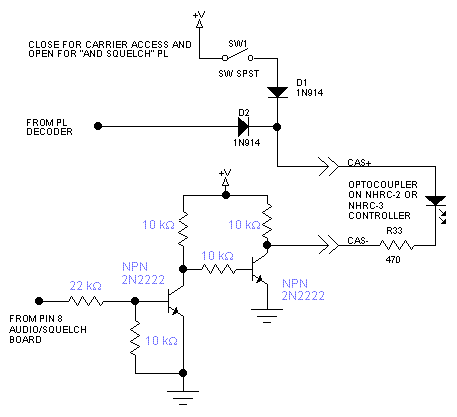
PL
and the NHRC-2 and NHRC-3 Controllers
By Kevin Custer W3KKC
Concept- The NHRC-2 and 3 repeater controllers do not have a dedicated PL or ctcss logic input, however the method stated here will allow a manual switch to be used to select between carrier or PL access. This manual switch could be replaced by a tone controlled switch if available for remote control of the access state. If only PL operation is desired, information is provided below for only PL access. See the circuit image below to understand hookup and operation. This information is provided specifically for installation to a Motorola MICOR, however the information can be used in general to allow operation from other radios.
Advantages- The "and squelch" logic function is used to provide crashless squelch tails if the proper jumper on the Audio & Squelch board is cut (see link below). Also, a switch can be used if desired to provide a means of selecting between Carrier or PL access.
Operation- If operated in the PL mode, the positive going PL decoder provides the plus signal for the controllers CAS+. A ground providing COS from the radio and transistor buffer provides the signal to the controllers CAS-. This is the neat part.... the controller will activate immediately upon getting both the COS and PL signals from the radio but will close or mute audio when either one is lost. Since the COS signal is usually lost first, logically "AND" squelch is provided. If the switch is closed, the signal from the PL decoder is not required and simply the buffered COS signal is used to activate the controller (Carrier Access). The 1N914 / 1N4148 diodes isolate the voltages provided by the PL decoder and the switch so destruction of the decoder doesn't result.
PL Only Operation- If PL only operation is desired, simply omit the switch SW1 and diode D1.
Note! The voltage provided to the switch should equal the bias voltage provided to the CAS- switching circuitry when idle. Why? In order for there to be no voltage across the CAS+ and CAS-, these voltages need to be the same when the repeater is idle. In the case of the Motorola MICOR, the switch and circuitry (V+) is provided with 9.6 volts. These two voltages need to be the same when idle otherwise bias to the LED in the optocoupler on the controller will result. This will make the controller think there is always a COS and will eventually result in time-out.

As stated this method provides the logic for PL as "AND Squelch". Go here to understand what this is and for specific modification instructions.
Back to the top of the page
Up one level
Back to Home
This page originally posted on 08-Aug-2000
Article text and layout © Copyright 08-Aug-2000 and date of last update by by Kevin K. Custer W3KKC and repeater-builder.com.
This web page, this web site, the information presented in and on its pages and in these modifications and conversions is © Copyrighted 1995 and (date of last update) by Kevin Custer W3KKC and multiple originating authors. All Rights Reserved, including that of paper and web publication elsewhere.